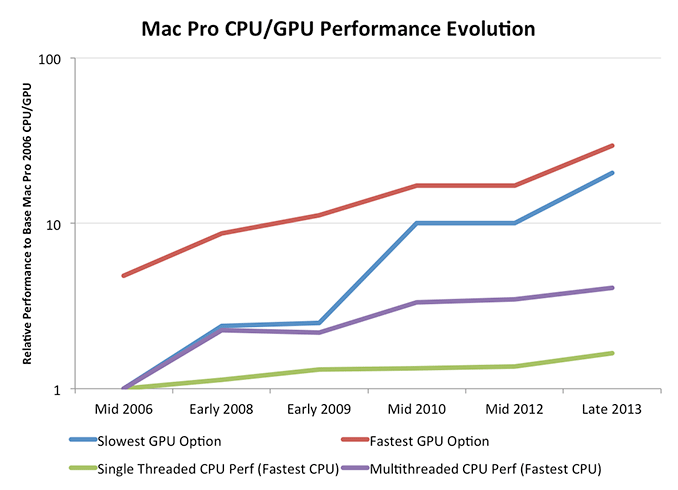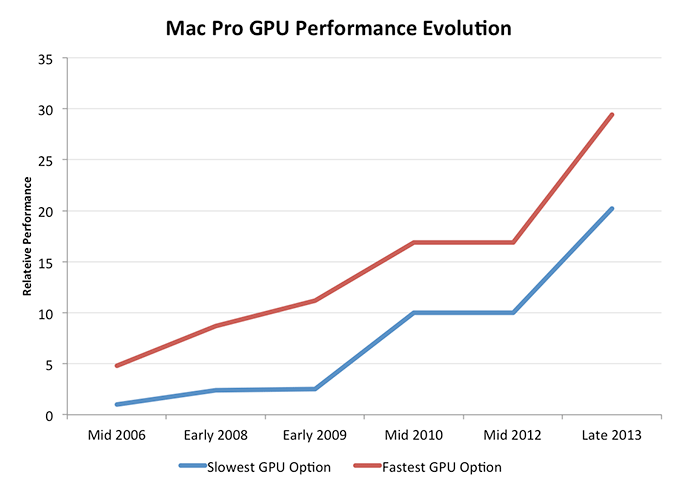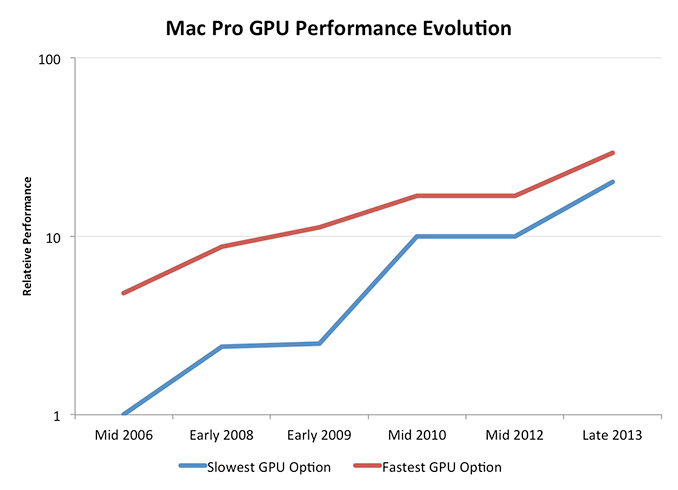The Mac Pro Review (Late 2013)
by Anand Lal Shimpi on December 31, 2013 3:18 PM ESTPlotting the Mac Pro’s GPU Performance Over Time
The Mac Pro’s CPU options have ballooned at times during its 7 year history. What started with four CPU options grew to six for the early 2009 - mid 2010 models. It was also during that time period that we saw an expansion of the number of total core counts from 4 up to the current mix of 4, 6, 8 and 12 core configurations.
What’s particularly unique about this year’s Mac Pro is that all configurations are accomplished with a single socket. Moore’s Law and the process cadence it characterizes leave us in a place where Intel can effectively ship a single die with 12 big x86 cores. It wasn’t that long ago where you’d need multiple sockets to achieve the same thing.
While the CPU moved to a single socket configuration this year, the Mac Pro’s GPU went the opposite direction. For the first time in Mac Pro history, the new system ships with two GPUs in all configurations. I turned to Ryan Smith, our Senior GPU Editor, for his help in roughly characterizing Mac Pro GPU options over the years.
| Mac Pro - GPU Upgrade Path | ||||||||||
| Mid 2006 | Early 2008 | Early 2009 | Mid 2010 | Mid 2012 | Late 2013 | |||||
| Slowest GPU Option | NVIDIA GeForce 7300 GT | ATI Radeon HD 2600 XT | NVIDIA GeForce GT 120 | ATI Radeon HD 5770 | ATI Radeon HD 5770 | Dual AMD FirePro D300 | ||||
| Fastest GPU Option | NVIDIA Quadro FX 4500 | NVIDIA Quadro FX 5600 | ATI Radeon HD 4870 | ATI Radeon HD 5870 | ATI Radeon HD 5870 | Dual AMD FirePro D700 | ||||
Since the Mac Pro GPU offerings were limited to 2 - 3 cards per generation, it was pretty easy to put together comparisons. We eliminated the mid range configuration for this comparison and only looked at scaling with the cheapest and most expensive GPU options each generation.
Now we’re talking. At the low end, Mac Pro GPU performance improved by 20x over the past 7 years. Even if you always bought the fastest GPU possible you'd be looking at a 6x increase in performance, and that's not taking into account the move to multiple GPUs this last round (if you assume 50% multi-GPU scaling then even the high end path would net you 9x better GPU performance over 7 years).
Ryan recommended presenting the data with a log scale as well to more accurately depict the gains over time:
Here you see convergence, at a high level, between the slowest and fastest GPU options in the Mac Pro. Another way of putting it is that Apple values GPU performance more today than it did back in 2006, so even the cheapest GPU is a much higher performing part than it would be.
If you’re a GPU company (or a Senior GPU Editor), this next chart should make you very happy. Here I’m comparing relative increases in performance for both CPU and GPU on the same graph:
This is exactly why Apple (and AMD) is so fond of ramping up GPU performance: it’s the only way to get serious performance gains each generation. Ultimately we’ll see GPU performance gains level off as well, but if you want to scale compute in a serious way you need to heavily leverage faster GPUs.
This is the crux of the Mac Pro story. It’s not just about a faster CPU, but rather a true shift towards GPU compute. In a little over a year, Apple increased the GPU horsepower of the cheapest Mac Pro by as great of a margin as it did from 2006 - 2012. The fastest GPU option didn’t improve by quite as much, but it’s close.

Looking at the same data on a log scale you’ll see that the percentage increase in GPU performance is slowing down over time, much like what we saw with CPUs, just to a much lesser extent. Note that this graph doesn't take into account that the Late 2013 Mac Pro has a second GPU. If we take that into account, GPU performance scaling obviously looks even better. Scaling silicon performance is tough regardless of what space you’re playing in these days. If you’re looking for big performance gains though, you’ll need to exploit the GPU.
The similarities between what I’m saying here about GPU performance and AMD’s mantra over the past few years aren’t lost. The key difference between Apple’s approach and those of every other GPU company is that Apple spends handsomely to ensure it has close to the best single threaded CPU performance as well as the best GPU performance. This is an important distinction, and ultimately the right approach.













267 Comments
View All Comments
LorneKwe - Friday, January 3, 2014 - link
How about we replace those Quadro 6000's with Radeon 7970s which are what the Mac Pro has inside. You can make any price comparison look like shit when you erroneously drop a few thousand dollars worth of GPUs into the build.Dual 6GB 7970s cost $1,400.
Using that, we can build out a 24C Dual Xeon 2697v2 workstation, with 64GB of RAM, dual 512GB 840 Pro SSDs in RAID0, H100i cooling on each CPU, and it would come to around $10,000. Same price as the Mac Pro's kitted out, 12C config, double the CPU power, and a good chunk more GPU power as they aren't underclocked.
You also have the option of going with 4x 7970s if you chose to, and if you forgo to ASUS Z9PE board for a proper workstation board, you can go up to 512GB of RAM instead of being capped at 64GB. If you want dual Quadro K5000s instead of 7970s, raise the PC's price by around $1600, but understand that these will outperform Apple's D700 pair by an enormous margin.
If you're looking for portability, or absolutely require OS X for what you do; choose the Mac Pro. If you're looking for computer power that won't throttle down when faced with tough workloads; have a full-fledged workstation built for you and get much more bang for your buck.
stingerman - Sunday, January 5, 2014 - link
Sorry Dude, this is a Pro Workstation, that mean workstation class GPUs. 7970 is a great CPU but there is a reason it doesn't go into Workstations...madwolfa - Sunday, January 5, 2014 - link
And what is it? Drivers? D700s in Mac Pro don't even have ECC memory enabled in them.wheelhot - Monday, January 6, 2014 - link
yes, the drivers provided (and I believe you can only test this in Windows?) will determine if it's actual workstation class GPUs or just Radeons with the name FirePro slapped on it. I'm seriously hoping it's supplied with actual workstation GPU driver, as it'll greatly benefit the software I use.LorneKwe - Tuesday, January 7, 2014 - link
I'd agree with you if we didn't have solid evidence that Apple's D700 is a repurposed 7970; lack of ECC memory being the best clue, and pricing being a great clue as well.scarhead - Saturday, January 4, 2014 - link
One Xeon E5-2697 processor costs $2,614. Two costs $5,228. I doubt your $3,712 figure for complete system is accurate.p51mustang6 - Thursday, January 2, 2014 - link
Apparently any comment disagreeing with the author gets deleted.chaos215bar2 - Friday, January 3, 2014 - link
Clearly not. Perhaps your comment was rude, trolling, and / or being argumentative without actually adding anything to the discussion?Johan Niklasson - Friday, January 3, 2014 - link
Great review - thanks. I just wanted to add that the new Mac Pro design and its finish does matter more than most people understand. The ones who work on graphic and video applications usually are artists with some sense of beauty and aesthetics. I am sure that the much more pleasant looking Mac Pro is a welcome addition to such people's workspaces.Also the smaller form factor and the silence will make it hard to resist!
james-bond - Friday, January 3, 2014 - link
Thanks for the great review. I wonder if some of the USB ports should have been on the other side of the chassis. Seems like the power cord and monitors are things that are rarely unplugged and are usually on the back side of current case designs. Having to reach around to plug and unplug a flash drive seems inconvenient.Please keep and eye out for an upgrade to Logic Pro (Apple's audio pro app). A would love for you to benchmark this in the same way you did Final Cut. I doubt Apple will be able to harness the second GPU for compute in audio applications do to latency in doing real time audio monitoring. Audio has taken a back seat to video apps in this version of the Mac Pro it seems.